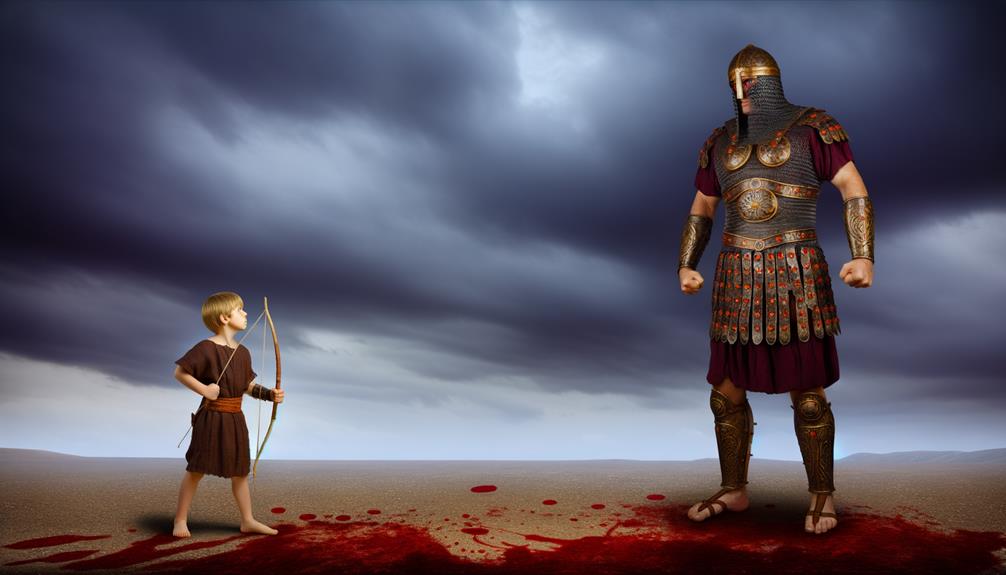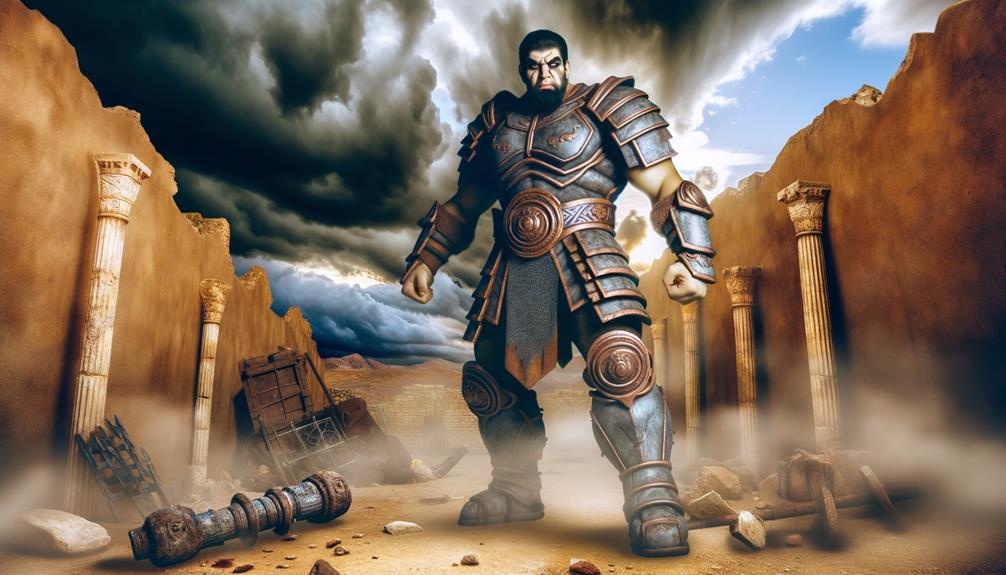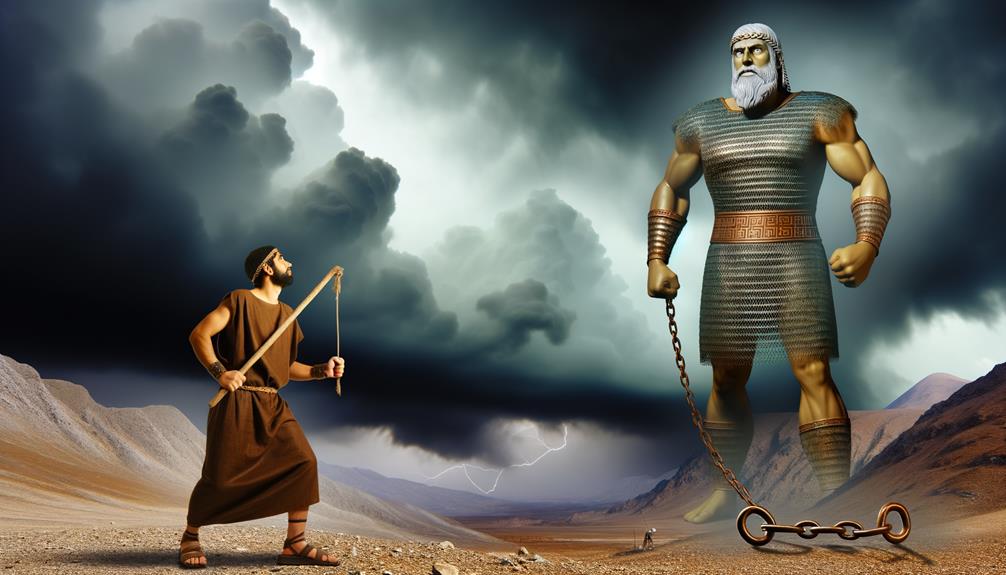Goliath Meaning In The Bible: Giants and Faith
In the Bible, Goliath is depicted as a colossal Philistine warrior who challenges the Israelites, embodying the quintessential adversary with overwhelming physical and psychological presence. His defeat by the young David, armed only with faith and a sling, underscores the triumph of divine support over sheer might.
This narrative serves as a theological allegory illustrating the potent dynamics of faith confronting and overcoming formidable obstacles. Additionally, Goliath symbolizes the arrogance and apparent invincibility often faced by believers, making his story a profound exploration of resilience and divine intervention.
Exploring this narrative further reveals deeper spiritual and ethical insights.

Goliath Meaning in the Bible: Symbol of Pride, Opposition, and Divine Victory
| Aspect | Biblical Interpretation |
|---|---|
| Identity | A Philistine giant and warrior defeated by David |
| Key Scripture | 1 Samuel 17 |
| Symbolism | Arrogance, fear, and worldly power opposing God’s will |
| Spiritual Lesson | Faith in God overcomes the greatest enemies |
| Moral Insight | God uses the humble to defeat the proud |
| Theological Message | Victory comes through trust in divine strength, not human might |
Historical Context of Goliath

The figure of Goliath, as depicted in the biblical narrative, emerges from a complex historical backdrop shaped by inter-tribal conflicts and cultural exchanges in the ancient Near East.
This period was characterized by frequent clashes among various groups, including the Israelites, Philistines, and other neighboring tribes.
The Philistines, often portrayed as a significant adversary to the Israelites, were an Aegean people who settled along the coastal regions of Canaan. Their advanced military technology and strategic prowess exacerbated regional tensions.
Goliath, as a Philistine warrior, symbolizes not only the immediate threat posed by these conflicts but also the broader struggles for power and dominance in a region marked by its volatile and dynamic socio-political landscape.
Goliath’s Physical Description

Towering over his adversaries, Goliath’s physical stature is meticulously detailed in the biblical account, emphasizing his formidable presence and the intimidating challenge he posed to the Israelites.
According to 1 Samuel 17:4, Goliath stood ‘six cubits and a span,’ approximately nine feet nine inches tall, though some texts suggest a shorter height. His armor, weighing around 125 pounds, included a bronze helmet, a coat of scale armor, greaves, and a javelin. The spear’s shaft was likened to a weaver’s beam, underscoring its massive size.
This detailed description serves not merely to illustrate Goliath’s physical might but to underscore the seemingly insurmountable odds faced by the Israelites, setting the stage for the profound theological themes explored in subsequent narratives.
The Battle With David

Goliath’s imposing physical attributes set the stage for his encounter with David, a seemingly mismatched confrontation that challenges conventional perceptions of strength and power. This biblical account, found in 1 Samuel 17, offers a narrative rich with themes of faith, courage, and divine intervention.
Key aspects of the battle include:
- David’s Refusal of Armor: David opts to face Goliath without traditional armor, relying instead on his sling and stones.
- Goliath’s Mockery: Goliath derides David, questioning the audacity of Israel to send a mere shepherd boy to fight him.
- David’s Faith Declaration: David proclaims his faith in God, attributing his forthcoming victory to divine support.
- Decisive Action: David’s precise strike with a stone to Goliath’s forehead results in the giant’s defeat, underscoring the triumph of faith over brute strength.
Symbolism of Goliath

The figure of Goliath in the biblical narrative symbolizes not only overwhelming odds, but also the embodiment of arrogance and a formidable challenge to faith.
His imposing stature and defiant demeanor represent the seemingly insurmountable obstacles that believers may encounter.
Consequently, Goliath serves as a powerful metaphor for the trials that test the resilience and conviction of one’s faith.
Representing Overwhelming Odds
As a symbol of overwhelming odds, Goliath in the biblical narrative epitomizes the immense challenges faced by individuals or communities when confronting seemingly insurmountable obstacles.
This representation can be analyzed through various contextual lenses:
- Historical Context: Goliath’s physical stature and armament represent tangible threats, mirroring the formidable adversaries encountered in ancient warfare.
- Psychological Impact: The fear and intimidation engendered by Goliath highlight the psychological barriers that often accompany intimidating challenges.
- Societal Reflection: Goliath symbolizes societal pressures and systemic issues, illustrating how collective adversities can appear undefeatable.
- Spiritual Significance: His portrayal underscores the spiritual trials that test faith and resilience, inviting deeper reflection on divine intervention and human perseverance.
Through these elements, Goliath’s symbolism as a representation of overwhelming odds is profoundly multifaceted.
Embodiment of Arrogance
In the biblical narrative, Goliath serves as a profound embodiment of arrogance, encapsulating the hubris and overconfidence that often precede downfall.
Standing as a colossal figure, Goliath’s disdainful challenge to the Israelites reflects a broader theme of pride that blinds one to potential consequences. His towering stature and formidable armor symbolize not just physical might, but an inflated sense of invincibility.
This arrogance is poignantly illustrated when he scoffs at David’s seemingly insignificant stature and weaponry. Goliath’s ultimate defeat by the young shepherd underscores a critical biblical lesson: excessive pride and self-reliance can lead to one’s ruin.
Consequently, Goliath’s characterization provides a timeless allegory on the perils of arrogance and the inevitable vulnerability it engenders.
Challenge to Faith
Goliath’s challenge to the Israelites epitomizes a profound test of faith, compelling them to confront their spiritual convictions in the face of seemingly insurmountable odds. The biblical narrative of David and Goliath serves as a potent symbol of the trials believers may encounter. This confrontation underscores several key elements:
Faith vs. Fear: The Israelites’ initial fear highlights the struggle between faith in divine power and human apprehension.
Divine Intervention: David’s victory signifies the triumph of faith and God’s intervention on behalf of the faithful.
Moral Courage: David’s bravery exemplifies the moral courage required to uphold faith amidst adversity.
Spiritual Insight: The story encourages spiritual insight, urging believers to perceive challenges as opportunities for divine glorification.
These elements collectively illuminate the multifaceted symbolism of Goliath’s challenge.
Lessons in Faith

The narrative of David and Goliath offers profound insights into the dynamics of faith and the power of belief in overcoming seemingly insurmountable challenges.
David’s unwavering trust in God exemplifies the essence of faith, transcending physical prowess and conventional wisdom. His reliance on divine support, rather than military might, underscores a theological principle: faith in a higher power can transform an individual’s capacity to confront adversity.
This story contextualizes faith not merely as belief, but as actionable confidence. David’s victory serves as a paradigmatic lesson that faith imbues strength and clarity, enabling believers to surmount obstacles regardless of their magnitude.
Hence, the tale reinforces the notion that true faith is both a spiritual and pragmatic force in human experience.
Modern Interpretations

Modern interpretations of Goliath extend beyond the biblical narrative, influencing contemporary culture and media.
The figure of Goliath has been appropriated as a symbol of formidable challenges in various contexts, from personal struggles to societal issues.
Additionally, Goliath’s presence in popular culture underscores its enduring resonance, manifesting in literature, film, and even corporate branding.
Cultural Relevance Today
Examining Goliath’s narrative in contemporary culture reveals nuanced interpretations that reflect both enduring and evolving societal values. The story of David and Goliath, once a mere biblical account, now serves as a metaphor for various modern contexts.
This metaphorical adaptation underscores the following themes:
- Underdog Triumph: Representing the victory of the seemingly weaker party against overwhelming odds.
- Personal Struggle: Symbolizing internal conflicts where individuals face their own ‘giants.’
- Corporate Dynamics: Illustrating the battles between small enterprises and large conglomerates.
- Social Justice: Highlighting the efforts of marginalized groups against systemic oppression.
These interpretations demonstrate Goliath’s transformation into a versatile symbol, relevant to a spectrum of contemporary issues, reflecting the persistent human quest for justice and resilience.
Symbolism in Pop Culture
In contemporary popular culture, the figure of Goliath has transcended its biblical origins to embody a broader archetype of formidable challenges and insurmountable odds. This symbolism permeates various media, representing not just physical might but also institutional power, systemic barriers, and personal adversities.
| Medium | Example |
|---|---|
| Literature | “David and Goliath” by Malcolm Gladwell |
| Film | “Rocky” (1976) |
| Television | “Game of Thrones” (The Mountain) |
These modern interpretations utilize the Goliath archetype to dramatize the struggles between underdogs and seemingly invincible adversaries.
By recontextualizing Goliath in contemporary narratives, creators highlight themes of resilience, strategy, and the triumph of the human spirit against overwhelming odds. This enduring metaphor continues to resonate, offering insights into both individual perseverance and societal dynamics.
Conclusion
Goliath, a towering figure in biblical narratives, represents both a literal and symbolic adversary.
His confrontation with David transcends mere physical combat, embodying themes of faith and divine intervention.
Historically contextualized, Goliath’s portrayal underscores the triumph of the underdog, epitomized in the adage, ‘the bigger they are, the harder they fall.’
This narrative continues to inspire, offering timeless lessons in courage and the enduring power of faith amidst seemingly insurmountable odds.






